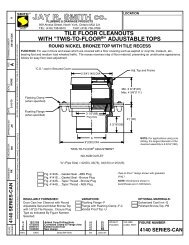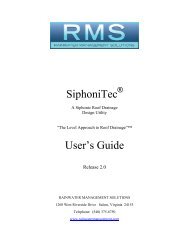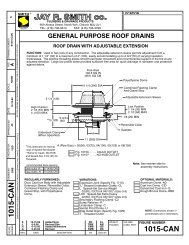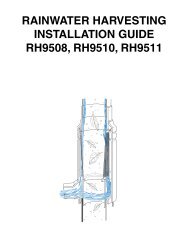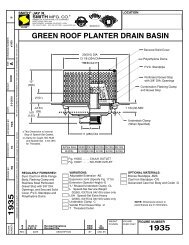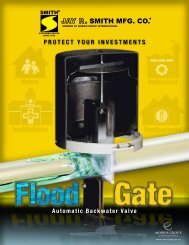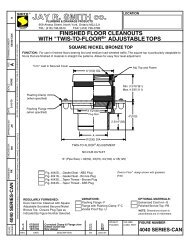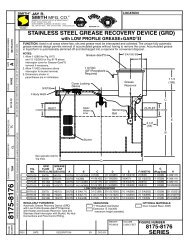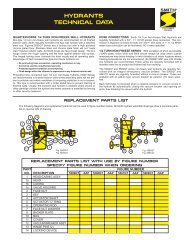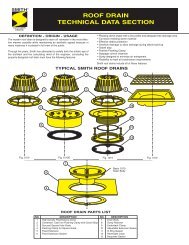Drip Irrigation Using a Rainwater Harvesting System - Jay R. Smith ...
Drip Irrigation Using a Rainwater Harvesting System - Jay R. Smith ...
Drip Irrigation Using a Rainwater Harvesting System - Jay R. Smith ...
Create successful ePaper yourself
Turn your PDF publications into a flip-book with our unique Google optimized e-Paper software.
would not only save on her municipal water billand give her available water in times of draught,but would resolve her runoff and pondingproblem. It addition, it would create an efficientway to irrigate her lawn and garden.Living in a progressive and innovative neighborhoodlike The Waters, she talked to her homebuilderabout the idea. They agreed that it would be abenefit for her home and would help showcaseThe Waters. The builder, Andrew and Dawson,of Pike Road, AL researched the idea. Theirinvestigations lead them to another localcompany, <strong>Jay</strong> R. <strong>Smith</strong> Mfg. Co., Montgomery, AL.<strong>Jay</strong> R. <strong>Smith</strong> Mfg. Co., in cooperation with theirpartners <strong>Rainwater</strong> Management Solutions andWISY AG, was the first U.S. Company to offera comprehensive product line of rainwaterharvesting filters and accessories.<strong>Rainwater</strong> harvesting systems are applicable tomost all types of buildings providing ready-touse,stored rainwater for landscaping, lawnirrigation, car washing, janitorial use, laundries,fire protection, or other non-potable uses.The concept of harvesting rainwater is simple;rainwater is collected from a rooftop. Theharvested rainwater is conveyed through thegutters and piping to a filter (Figure NumberRH9520-04, Vortex <strong>Rainwater</strong> Fine Filter) thatremoves the debris from the rainwater. From thefilter, the collected rainwater enters the concretestorage tank through a smoothing inlet (FigureNumber RH9530SI). The smoothing inlet preventsthe agitation of sediment at the rainwater inletinto the storage tank and it aerates the water tokeep it from becoming foul smelling. The storedrainwater is now ready for use. Harvestedrainwater is extracted from the cleanest part ofthe tank, just below the surface of the water usingthe floating filter (Figure Number RH9532) andpump. The end result is ph-neutral, soft, filteredwater which is naturally well suited for irrigation.In order to size the system properly, it wasimportant for Andrew and Dawson to accuratelycalculate the surface area of all roof sectionswhere rainwater is to be collected. In this case,the Gerachis’ wanted to maximize their rainwaterharvesting potential. They decided tocapture rainwater from the entire roof area, thefront and back porches, and the carport. The totalcollection area equaled 2,151 square feet.During the design process it became apparentthat the rainwater storage tank would be apivotal component of the system. The Gerachis’had planned for an elaborate backyard garden, sothe capacity of the concrete storage tank neededto meet their irrigation needs. In the end, a 2,000gallon capacity tank was buried in the ground toleave the entire backyard open for gardening.Gerachis’ Backyard: Piping from the home to the vortex fine filter, then to the concrete storage tank.
All of the rainwater collections piping trencheswere dug and the piping was installed to thevortex filter and into the storage tank. The systemwas then tested and trenches were backfilled.To prevent the concrete storage tank from “floating”a one-foot layer of concrete and a one-footflange were poured before dirt was backfilledover the tank.The harvested rainwater is used strictly foroutdoor needs. It provides water for two hosebibbs and several hundred feet of drip irrigationlines. Proper design for the intended use isalways important in rainwater harvestingapplications. As Cathy Gerachis said, “Welooked at several alternatives, but they were allso wasteful. We could have drilled a well, butthat would have exceeded our demand, andpersonally I did not like the idea of wastingwater.”There are many benefits of using <strong>Rainwater</strong>:• It is free; the only cost is installation and use.• It lessens demand on the municipal watersupply.• It saves money on utility bills.• It makes efficient use of a valuable resource.• It diminishes flooding, erosion, and the flow tostormwater drains.• It can be used to recharge ground water.• It reduces the contamination of surface waterwith sediments, fertilizers and pesticides fromrainwater run-off resulting in cleaner lakes,rivers, oceans and other receivers ofstormwater.• It is good for irrigation and plants thrivebecause stored rainwater is free from pollutantsas well as salts, minerals, and other natural andman-made contaminants.• It adds life to equipment dependent on waterto operate, as rainwater does not producecorrosion or scale like hard water.• It can help you achieve LEED® Green BuildingRating Credit under Water Use Reduction,Water Efficient Landscaping, and Storm WaterManagement.The Gerachis’ home backyard now features amultitude of beautiful plants. They have vegetable,herb, and flower gardens along with variousflower beds, shrubs, and trees.About The Waters Community:The Waters is a neighborhood communitynestled in the town of Pike Road, Alabama,located just outside of Montgomery. Thehundreds of acres include expansive rollinggreenways, towering oaks, and over five milesof shoreline wrapping around the 200 acreLake Cameron. Around the neighborhood youwill find everything from manicured parks tomid-block greens.Other amenities abound, such as, a pooland community pavilion, boathouses, piers,tennis and basketball courts, a local market,dentist office, and a YMCA.The homes are built with traditional southernarchitecture and premium green-buildingmaterials such as, metal roofs, radiant windows,geo-thermal heating and cooling unitsand spray foam insulation. New efficiencymethods such as rainwater harvesting arealso used to lessen utility bills and limit waterrunoff. Other construction techniques such as,deep-anchored raised foundations and ampleeight foot porches are used throughout thecommunity.Whether your ideal is found in a grand mansionor a cozy cottage, a classic brownstoneor a cozy city-cool loft, you’ll discover homesare as detailed as any other historic examples.When a neighborhood is built from traditionalmodels, special things begin to happen. Asense of community develops and a socialnetwork begins. The Waters is a quality of lifewhere people are brought together to form asense of community for all ages.The rainwater harvesting installation at theGerachis’ home is almost unnoticeable. Only thetop of the vortex filter is visible. Andrew Gerachis,Assistant Director for Marketing and Sales at TheWaters states, “We wanted to leave the vortexfilter visible because it makes for a great conversationpiece, and that is really what this is about,educating everyone you can on how important itis to re-use what nature provides”.For more information on <strong>Rainwater</strong><strong>Harvesting</strong> Products, visitwww.jrsmith.com



